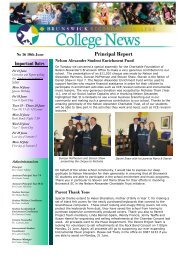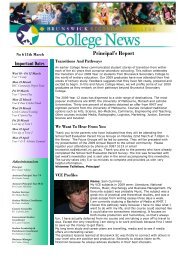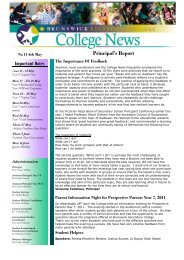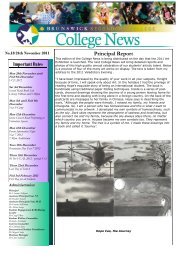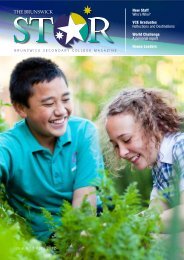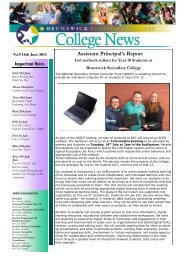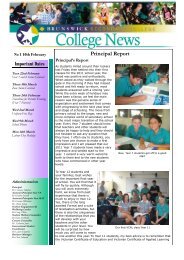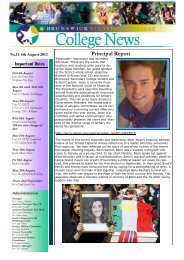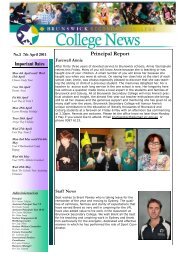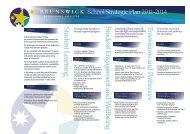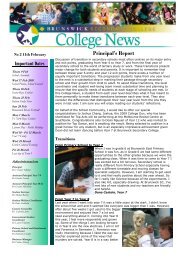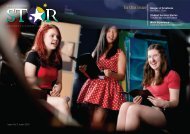BSC 2010 Annual Report.pdf - Brunswick Secondary College
BSC 2010 Annual Report.pdf - Brunswick Secondary College
BSC 2010 Annual Report.pdf - Brunswick Secondary College
- No tags were found...
You also want an ePaper? Increase the reach of your titles
YUMPU automatically turns print PDFs into web optimized ePapers that Google loves.
<strong>2010</strong> <strong>Annual</strong> <strong>Report</strong> tothe School Community<strong>Brunswick</strong> <strong>Secondary</strong> <strong>College</strong>School Number: 8807
Government School PerformanceSummary <strong>2010</strong>What our school is doing<strong>Brunswick</strong> <strong>Secondary</strong> <strong>College</strong><strong>Brunswick</strong> SC is a vibrant school that has over the past decade grown steadily in enrolment, reputation and results. While itsstudents are drawn mainly from <strong>Brunswick</strong> and Coburg, it also attracts students from beyond this area. The Region has givenapproval for the <strong>College</strong> to grow from 900 to1100.The <strong>College</strong> genuinely reflects the composition and aspirations of its community. We have a Select Entry Accelerated LearningProgram, an English Language Centre and a small community of international students. VCE results over the past 4 years havebeen consistently higher than expected on the school comparison measure.The <strong>College</strong> offers a traditional discipline-based curriculum complemented by a rich range of Specialist Subjects. We have a focuson student development and excellence, offering students a wide range of enrichment and extension programs. The <strong>College</strong>’sMusic, Sport and Debating programs are highly successful.Our school fosters a culture that promotes the values of teamwork, persistence, responsibility, achievement and excellence foundedon the core value of respect. We are committed to the development of young people who live successful and constructive lives, withpositive personal values and a strong sense of community. Parent satisfaction with the school is high.Student LearningVCE results over the past 4 years havebeen consistently higher than expectedon the school comparison measure. Aspart of a commitment to highexpectations, we measure Year 7-12student work practices four times peryear. The 2009 and <strong>2010</strong> Year 12 cohortsare the first to have met the year leveltarget of an average work practice of 3.7out of 4 and a median study score of 31.In Year 7-10, teacher assessment andNAPLAN data show <strong>Brunswick</strong><strong>Secondary</strong> <strong>College</strong>’s performance isabove the median of all governmentsecondary schools. Reciprocal Teaching,a strategy explicitly targetting the skillsgood readers use, is a factor in the strongReading result. The Purposeful Teachingin Numeracy strategies, introduced in<strong>2010</strong>, have begun to contribute toenhanced performance in Numeracy.In 2011, our whole school studentlearning goal continues to be for allstudents to make or exceed expectedlevels of progress. Our teachers willcontinue to work in teams to use studentfeedback and achievement data toimprove the performance of studentsachieving at, below and above expectedlevels.Student Engagementand Wellbeing<strong>Brunswick</strong> SC provides a supportive andsafe learning environment with the 'right tolearn' and 'respect for diversity' as clearlyunderstood tenets.The <strong>College</strong> offers many programs tostrengthen and develop students'confidence and skills including Duke ofEdinburgh, Sports Leadership, and RockEisteddfod. All students are involved insetting goals for improvement. There is astrong and active student leadership teamled by a team of highly motivated SchoolCaptains.The measure for Connectedness toSchool is just above the state average. In<strong>2010</strong>, it was the lowest scoring item on the<strong>2010</strong> Student Attitudes to School Survey.Student Motivation, Learning Confidence,Teacher Effectiveness and TeacherEmpathy are the highest rated items.Student Voice is important in the school.The <strong>College</strong> conducts bi-annual surveys inwhich all teachers receive individualfeedback from every student they teach.In <strong>2010</strong>, the average student absence ratewas 17.0 days. We aim to reduce theaverage absence further by targettingYear 9 and the small number of studentswith very high absence rates.Student Pathwaysand TransitionsPerfomance in Student Pathways andTransitions is at state average. Theschool’s retention percentage for 2006-2009 is similar to other governmentschools noting that student movement ismainly due to families relocating out of thearea.The percentage of Year 10-12 studentsgoing on to further studies or full timeemployment in 2006 -2009 was above thestate median. Data for <strong>2010</strong> destinationwill be available in May. More detailedanalysis shows the percentage of Year 12going on to further study is higher than thestate wide median.The issue of provision for senior studentswishing to pursue a non-academicpathway has been addressed in 2011 withthe introduction of Year 11 VCAL andexpansion of VET. The PathwaysCoordinator will continue to track andsupport our exit students. In 2011,CareersEducation is being extended into Year 9.There is a developed process for thetransition of primary school students. Newgoals include developing more seamlessand effective transition between year levelsand providing an Induction program, andpeer support for students transferring into<strong>Brunswick</strong> SC from other schools.For more detailed information regarding our school please visit our website atwww.brunswick.vic.edu.auor view our <strong>2010</strong> <strong>Annual</strong> <strong>Report</strong> online at http://www.vrqa.vic.gov.au/SReg/
Government School PerformanceSummary <strong>2010</strong><strong>Brunswick</strong> <strong>Secondary</strong> <strong>College</strong>How this school compares to allVictorian government schoolsKey:Range of results for the middle 60% of Victorian government schools:Result for this school: Median of all Victorian government schools:This page provides the overall picture of this school's performance in the past year.The following pages provide more detail on each of these measures.Overall Measures Student Outcomes School ComparisonResults achieved by students at this schoolcompared to students at other Victoriangovernment schools.Whether this school, taking into account itsstudents, is performing higher than, lowerthan, or broadly similar to other schools,taking into account their students.1. Student LearningCombining teacher assessments from theVictorian Essential Learning Standards(VELS), the results from the NationalAssessment Program – Literacy andNumeracy (NAPLAN) tests and theVictorian Certificate of Education (VCE).LowerOutcomesHigherOutcomesLower Similar Higher2. Student Engagement and WellbeingCombining student attendance rates andresults from the annual student Attitudesto School survey.LowerOutcomesHigherOutcomesLower Similar Higher3. Student Pathways and TransitionsCombining the number of studentsremaining at school through to Year 10and students going on to further study orfull-time employment from Years 10 to 12.LowerOutcomesHigherOutcomesLower Similar HigherSchool Profile● Average level of parent satisfaction ● Average level of staff satisfaction ● Overall socio-economic profilewith the school, as derived from with the school, as derived fromthe annual Parent Opinion survey. the annual Staff Opinion survey.low low-mid midThe score is reported on a scale The score is reported on a scaleof 1 to 7, where 7 is the highest of 1 to 5, where 5 is the highestpossible score.possible score.1mid-high● Proportion of students with English as a second language7 1 5low low-mid mid mid-high highhighBased on the school's Student Family Occupation indexwhich takes into account parents' occupations.●All Victorian government school teachers meet the registrationrequirements of the Victorian Institute of Teaching (www.vit.vic.edu.au).●948 students (380 female, 568 male) were enrolled at thisschool in <strong>2010</strong>.For more information regarding this school, please visit www.vrqa.vic.gov.au/sregvic au/sreg8807 Version 1, February 2011
<strong>Brunswick</strong> <strong>Secondary</strong> <strong>College</strong>How this school compares to allVictorian government schoolsKey:Range of results for the middle 60% of Victorian government schools:Result for this school: Median of all Victorian government schools:Student Learning Student Outcomes School Comparison4. Teacher assessments from theVictorian Essential Learning Standards(VELS)Percentage of students in Years 7 to 10with a grade of C or above in:● English and Mathematics● All other subjectsThe grades are the same as those usedin your child's end of year report.A ‘C’ rating means that a student is at thestandard expected at the time ofreporting.000Results: English and Mathematics 2009Results: English and Mathematics2007 - 2009 (3-year average)Results: All other subjects 2009Results: All other subjects2007 - 2009 (3-year average)100100100Lower Similar HigherLower Similar HigherLower Similar Higher01005. NAPLAN Year 7 Results: Reading <strong>2010</strong>Average score achieved on the NAPLANReading and Numeracy tests conductedin May each year.Year 7 assessments are reported on ascale from Bands 4-9.Bands represent different levels ofachievement. For Year 7, the NationalMinimum Standard is at Band 5.Band 4 5 6 7 8 9Results: Reading 2008 - <strong>2010</strong>(3-year average)Band 4 5 6 7 8 9Results: Numeracy <strong>2010</strong>Lower Similar HigherBeing the first year of secondaryschool, Year 7 NAPLAN is not used forthe School Comparison.Band 4 5 6 7 8 9Results: Numeracy 2008-<strong>2010</strong>(3-year average)Band 4 5 6 7 8 96. NAPLAN Year 9 Results: Reading <strong>2010</strong>Average score achieved on the NAPLANReading and Numeracy tests conductedin May each year.Year 9 assessments are reported on ascale from Bands 5-10.Bands represent different levels ofachievement. For Year 9, the NationalMinimum Standard is at Band 6.Band 5 6 7 8 9 10Results: Reading 2008 - <strong>2010</strong>(3-year average)Band 5 6 7 8 9 10Results: Numeracy <strong>2010</strong>Lower Similar HigherLower Similar HigherBand 5 6 7 8 9 10Results: Numeracy 2008-<strong>2010</strong>(3-year average)Lower Similar HigherBand 5 6 7 8 9 10Lower Similar HigherVersion 1, February 2011
<strong>Brunswick</strong> <strong>Secondary</strong> <strong>College</strong>How this school compares to allVictorian government schoolsKey:Range of results for the middle 60% of Victorian government schools:Result for this school: Median of all Victorian government schools:Student Learning Student Outcomes School Comparison7. Victorian Certificate of Education (VCE) Results: <strong>2010</strong>Mean study score from all VCE subjectsundertaken by students at this school.This includes all Unit 3 and 4 studies(including those completed in Year 11)and any VCE VET studies awarded astudy score. The maximum student studyscore is 50 and the state-wide mean(including government and nongovernmentschools) is set at 30.0 50Results: 2007 - <strong>2010</strong> (4-year average)0 50Lower Similar HigherLower Similar HigherPercent of students in <strong>2010</strong> who satisfactorily completed their VCE: 100%Percent of Year 12 students in <strong>2010</strong> undertaking at least one Vocational Education and Training (VET) unit of competence: 2%Percent of VET units of competence satisfactorily completed in <strong>2010</strong>: 100%Percent of Victorian Certificate of Applied Learning (VCAL) credits satisfactorily completed in <strong>2010</strong>: N/AStudent Engagement Student Outcomes School Comparisonand Wellbeing8. Student attendance Results: 2009Average attendance rate of all students inthe school. Common reasons for nonattendanceinclude illness and extendedfamily holidays.0 100Results: 2006 - 2009 (4-year average)0 100Lower Similar HigherLower Similar HigherAverage 2009 attendance rate by year level:Yr7 Yr8 Yr9 Yr10 Yr1192% 89% 88% 89% 93%Yr1294%9. Student attitudes to school Results: <strong>2010</strong>Derived from the Attitudes to Schoolsurvey completed annually by Victoriangovernment school students in Years 5 to12. It includes questions about students’engagement in and enjoyment of school.The school’s average score is reportedhere on a scale of 1 to 5, where 5 is thehighest possible score.1 5Results: 2007 - <strong>2010</strong> (4-year average)1 5Lower Similar HigherLower Similar HigherStudent Pathways Student Outcomes School Comparisonand Transitions10. Student retention Results: 2009Percentage of Year 7 students whoremain at the school through to Year 10.11. Students exiting to further studies andfull-time employmentPercentage of students from Years 10 to12 going on to further studies or full-timeemployment.0100Results: 2006 - 2009 (4-year average)0 100Results: 20090 100Results: 2006 - 2009 (4-year average)0 100Lower Similar HigherLower Similar HigherLower Similar HigherLower Similar HigherVersion 1, February 2011
How to readtheGovernment SchoolPerformanceSummary <strong>2010</strong>The Government School Performance Summaryprovides anoverview ofhow this school is performing, andhow it compares to all other Victorian government schools.All schools acknowledgee the partnership and support of theirparents andthe community in working togetherto improve outcomes for children and young people.By sharing this information with the community, our goal is toidentify where we needto improve and to worktogether to achieve excellence in every school.The first page outlines whatyour school is doing toimproveits results.The second page summarisesyour school’s performance.The third and fourth pagesprovide a detailed breakdownof each of the result areas.What are student outcomes?Student outcomes showthe achievements ofstudents in this school inEnglish, Mathematics andother subjects. They also show results in nationalliteracy and numeracy tests and, forsecondarycolleges, the Victorian Certificate of Education(VCE) examinations. They provide importantinformation about student attendance andengagement at school.For secondary colleges,the Government SchoolPerformance Summary also provides informationnabout how many students at this school go on tofurther studies or full-time work afterleaving school.You can seee these results for the latest year, as wellas the average of the last four years(whereavailable).The Government School Performance Summaryalso allows you to compare student outcomes forstudents at this school with the outcomes ofstudents in all other Victorian government schools.
What is a School Comparison?The School comparison is a way of comparingschool performance that takes into account thedifferent student intake characteristics of eachschool.A School comparison takes into account the school’sacademic intake, the socio-economic backgroundof students, the number of Indigenous students, thenumber of non-English speaking and refugeestudents, the number of students with a disability,and the size and location of the school.The School comparison measures show that mostschools are doing well and are achieving resultsthat are ‘similar’ to what we would estimate giventhe background characteristics of their students.Some schools are doing exceptionally well with thestudents they have, and have ‘higher’ performance.Some schools have ‘lower’ performance after takinginto account their students’ characteristics – theseschools will receive targeted support to ensure thatthere is improvement.Looking at both the student outcomes and schoolcomparisons provides important information aboutwhat a school is doing well and the areas thatrequire further improvement.More information on school comparisonperformance measures can be found at:www.education.vic.gov.au/aboutschool/What is the meaning of ‘Data not available’?For some schools, there are too few students toprovide data. For other schools, there are no studentsat some levels, so school comparisonsare not possible. Newly opened schools have only thelatest year of data and no averages from previousyears. The Department also recognisesthe unique circumstances of Specialist, Select Entry,English Language and Community Schools whereschool comparisons are not appropriate.What is this school doing to improve?All schools have a plan to improve outcomes fortheir students. The ‘What our school is doing’statement provides a summary of this school’simprovement plan.
Financial Performanceand Position<strong>Brunswick</strong> <strong>Secondary</strong> <strong>College</strong>Financial Performance – Operating StatementSummary for the year ending 31st December,<strong>2010</strong>Financial Position as at 31st December, <strong>2010</strong>Revenue <strong>2010</strong> Actual Funds Available <strong>2010</strong> ActualDepartmental Grants $960,054 High Yield Investment Account $357,221Commonwealth Government Grants $157,604 Official Account $48,859State Government Grants $0 Other Bank Accounts( listed individually)Other $214,736 Building Fund $297Locally Raised Funds $609,827 Library Fund $809Total Operating Revenue $1,942,221 At Call Investments - MECU $521,474ExpenditureSalaries and Allowances $260,064Bank Charges $3,494 Total Funds Available $928,659Consumables $224,138Books and Publications $8,202 Financial Commitments <strong>2010</strong> ActualCommunication Costs $34,168 School Operating Reserve $254,776Furniture and Equipment $254,904 Assets or Equipment Replacement ‹12 months $68,968Utilities $65,627 Capital – Building/Grounds including SMS ‹ 12 $306,358Property Services $420,188 monthsTravel and Subsistence $40,352 Maintenance – Building/Grounds including $15,000Motor Vehicle Expenses $6766SMS ‹ 12 monthsAdministration $48,354 Beneficiary/Memorial Accounts $Health and Personal Development $1,816 Co-operative Bank Account $Professional Development $22,460 Revenue Receipted in Advance $47,020Trading and Fundraising $14,567 School based programs $18,448Support/Service $38,246 Region/Network/Cluster Funds $Miscellaneous $336,530 Provision Accounts $50,000Total Operating Expenditure $1,773,786 Repayable to DEECD $Other Recurrent Expenditure (Accounts Payable) $Net Operating Surplus/-Deficit $168,435 Assets or Equipment Replacement › 12 $148,089Capital Expenditure $624,535Please note that the above amounts do not include anycredit revenue or expenditure allocated or spent by theschool through its Student Resource PackageCapital – Building/Grounds including SMS › 12monthsMaintenance - Building/Grounds includingSMS › 12 months$20,000Total Financial Commitments $928,659$Financial performance and position commentaryIn <strong>2010</strong> <strong>Brunswick</strong> <strong>Secondary</strong> <strong>College</strong> managed its finances in line with DEECD processes and guidelines. There was a clearsegregation of duties to ensure that prudent checks and balances were in place with regard to budgeting, receipting and expenditureof funds. The School Council exercised responsibility for overseeing the program and the receipt of timely reports .Income for <strong>2010</strong>was approximately 8% less than in 2009. This is primarily due to NSSCF funding provided in 2009 not being available in <strong>2010</strong> anda reduction in overseas paying students. Expenditure on property services accounted for 24% and self funded camps & excursionsaccounted for 15% of total <strong>2010</strong> expenditure. The amounts of funds available to commence the new school year has reduced,largely due to an increase in capital expenditure. The Financial commitments increased due to an ongoing requirement to maintainbuildings, grounds and other assets. During <strong>2010</strong>, staff development has been supported to a very high level in the firm belief thatimproved teaching will directly lead to continued improvement in student achievement. Locally raised funds accounts for more than31% of the <strong>2010</strong> income. This continued support allows the school to maintain and improve facilities, grounds and resources. Theschool maintains DEECD recommendation to have an operating reserve. The school is involved in the Master Plan stage of BuildingFutures. The $500,000 invested in the High Yield Account is set aside for retractable seating and other furniture and furnishings forthe planned redevelopment of the Performing Arts /Gym area. Appropriate amounts have been expended on student learning withpleasing student achievement noted across the school.



